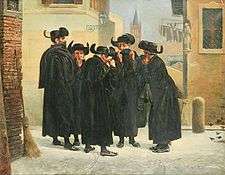History of the Jews in the Czech Republic
| Židé v Česku Tschechischen Juden יהודי צ'כיה טשעכיש אידן | |
|---|---|
 | |
| Total population | |
| ~4,000 | |
| Regions with significant populations | |
| Languages | |
| Czech, German, Yiddish, Hebrew | |
| Religion | |
| Judaism | |
| Related ethnic groups | |
| Jews, Ashkenazi Jews, Slovak Jews, Austrian Jews, German Jews, Hungarian Jews, Ukrainian Jews |
| Historical Czech Jewish population | ||
|---|---|---|
| Year | Pop. | ±% |
| 1921 | 125,083 | — |
| 1930 | 117,551 | −6.0% |
| 1945 | 18,000 | −84.7% |
| 1970 | 7,000 | −61.1% |
| 2000 | 4,000 | −42.9% |
| 2010 | 3,900 | −2.5% |
| Source: [1][2][3] | ||
Jews in Bohemia (also known as Bohemian Jews/Czech Jews), today's Czech Republic, are predominantly Ashkenazi Jews,[4] and the current Jewish population is only a fraction of the pre-Holocaust Jewish population. As of 2005, there were approximately 4,000 Jews living in the Czech Republic.[5] There is evidence that Jews have lived in Moravia and Bohemia since as early as the 10th century.[6]
Jewish Prague
Jews are believed to have settled in Prague as early as the 10th century. The 16th century was a golden age for Jewry in Prague. One of the famous Jewish scholars of the time was Judah Loew ben Bezalel known as the Maharal, who served as a leading rabbi in Prague for most of his life. He is buried at the Old Jewish Cemetery in Josefov, and his grave with its tombstone intact, can still be visited. It is said that the body of Golem (created by the Maharal) lies in the attic of the Old New Synagogue where the genizah of Prague's community is kept.[7] In 1708, Jews accounted for one-quarter of Prague’s population.[8]
Austro-Hungarian Empire
As part of the original Czechoslovakia, and before that the Austro-Hungarian Empire the Jews had a long association with this part of Europe.[9] Throughout the last thousand years there have emerged over 600 Jewish communities in the Kingdom of Bohemia.[10] According to the 1930 census, Czechoslovakia (including Subcarpathian Ruthenia) had a Jewish population of 356,830.[11]
The Holocaust
In contrast to Slovak Jews, who were mostly deported by the First Slovak Republic directly to Auschwitz, Treblinka, and other extermination camps, most Czech Jews were initially deported by the German occupiers with the help of local Czech Nazi collaborators to Theresienstadt concentration camp and only later killed. However, some Czech Jewish children were rescued by Kindertransport and escaped to the United Kingdom and other Allied countries. Some were reunited with their families after the war, while many lost parents and relatives to the concentration camps.
It is estimated that of the 118,310 Jews living in the Protectorate of Bohemia and Moravia upon the German invasion in 1939, 26,000 emigrated legally and illegally; 80,000 were murdered by the Nazis; and 10,000 survived the concentration camps.[12]
Today

Prague has the most vibrant Jewish life in the entire country; several synagogues operate on regular basis; there are three kindergartens, a Jewish day school, two old age homes, five kosher restaurants, two mikvaot, a kosher hotel. Three different Jewish magazines are being issued every month. The Prague Jewish Community officially has about 1,500 members but the real number of Jews in the city is estimated to be much higher; between 7,000 and 15,000. Due to years of prosecution by both the Nazis and the subsequent Communist regime, however, most people do not feel comfortable of being registered as such. Moreover, the Czech society is the most secular in the EU.[13]
There are ten small Jewish communities around the country (seven in Bohemia and three in Moravia), the largest one being in Prague, where close to 90% of all Czech Jews live. The umbrella organisation for the Jewish communities and organisations in the country is the Federation of Jewish Communities (Federace židovských obcí, FŽO). Services are regularly held in Prague, Brno, Olomouc, Teplice, Liberec and irregularly in some other cities.
See also
References
- ↑ "YIVO | Czechoslovakia". Yivoencyclopedia.org. Retrieved 2013-04-16.
- ↑ "YIVO | Population and Migration: Population since World War I". Yivoencyclopedia.org. Retrieved 2013-04-16.
- ↑ "Archived copy" (PDF). Archived from the original (PDF) on 2012-02-09. Retrieved 2012-03-15.
- ↑ http://www.jewishgen.org/austriaczech/MilaRechcigl.html
- ↑ The Virtual Jewish Library - Jewish population of Czech republic, 2005
- ↑ "The Jews of the Czech Republic". The Museum of the Jewish People at Beit Hatfutsot.
- ↑ "''The Golem'', Temple Emanu-El, San Jose". Templesanjose.org. Archived from the original on 2013-09-16. Retrieved 2013-04-16.
- ↑ Prague, The Virtual Jewish History Tour
- ↑ "The Jews and Jewish Communities of Bohemia in the past and present". Jewishgen.org. 2013-04-02. Retrieved 2013-04-16.
- ↑ "Czech Synagogues and Cemeteries". Isjm.org. 2003-01-04. Retrieved 2013-04-16.
- ↑ "The Holocaust in Bohemia and Moravia". Ushmm.org. Retrieved 2013-04-16.
- ↑ Kulka, Erich (1987). Jews in Svoboda's army in the Soviet Union : Czechoslovak Jewry's fight against the Nazis during World War II. Lanham, Md.: Univ. Press of America. p. xviii. ISBN 9780819165770.
- ↑ http://www.pewresearch.org/fact-tank/2017/06/19/unlike-their-central-and-eastern-european-neighbors-most-czechs-dont-believe-in-god/